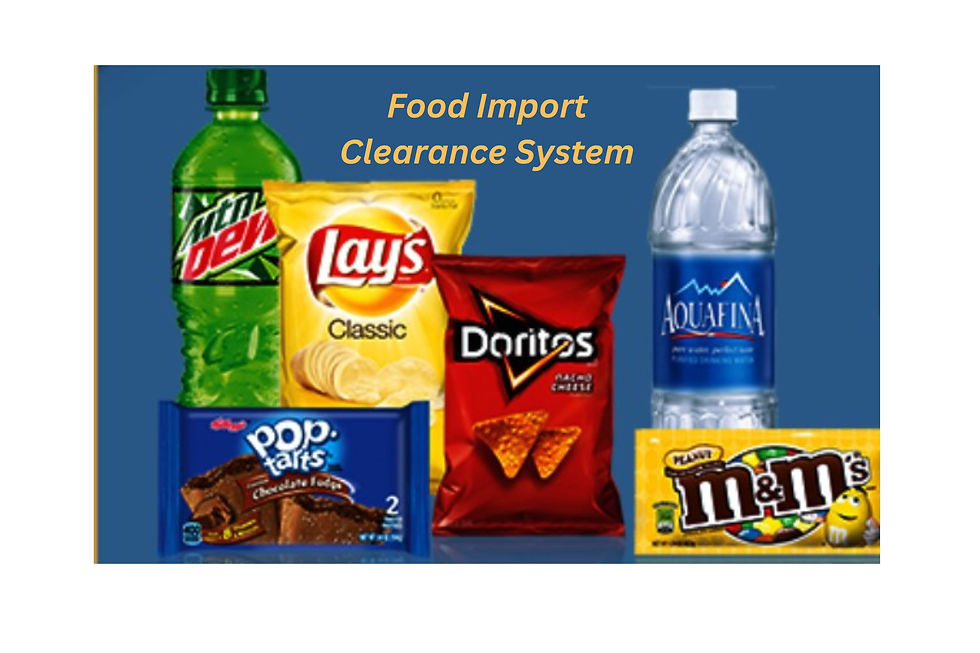What are the key components of a food import clearance system?
- Food Magazine Official
- Sep 14, 2023
- 3 min read

Introduction
In an interconnected global economy, the importation of food products plays a vital role in meeting the diverse culinary demands of consumers worldwide. However, ensuring the safety and quality of imported food items is of paramount importance. This is where a well-structured food import clearance system comes into play. In this article, we will explore the key components of a food import clearance system and why they are crucial for safeguarding public health and maintaining food security.
Regulatory Framework
A robust food import clearance system begins with a comprehensive regulatory framework. Government agencies and international bodies establish rules and regulations to govern the importation of food products. These regulations encompass safety standards, labeling requirements, and documentation procedures. Harmonization with international standards, such as those set by the World Trade Organization (WTO) and the Codex Alimentarius, is essential to facilitate smooth trade while ensuring food safety.
Importer Registration
To participate in food imports, businesses must register with relevant government agencies. This step allows authorities to keep track of importers, ensuring that they comply with all regulations. Importer registration is also a means of accountability, enabling authorities to trace the source of food products in case of a safety or quality issue.
Risk Assessment
Risk assessment is a critical component of the food import clearance system. It involves evaluating the potential hazards associated with imported food products. Risk factors may include the origin of the product, production methods, and previous compliance history. Authorities use risk assessment to determine the level of scrutiny each shipment should undergo, with higher-risk products receiving more thorough inspections.
Documentation and Labeling
Accurate documentation and labeling are essential for traceability and consumer protection. Importers must provide detailed information on the food products they bring into the country, including the source, composition, and production methods. Additionally, labeling requirements must adhere to national and international standards to ensure consumers have access to clear and accurate information about the products they purchase.
Inspection and Testing
Physical inspection and laboratory testing are key components of a food import clearance system. Inspectors examine shipments to verify that they comply with safety and quality standards. Additionally, they may take samples for laboratory testing to assess the presence of contaminants, pathogens, or other harmful substances. Inspection and testing help prevent unsafe or substandard products from entering the market.
Border Control
Border control facilities play a crucial role in the clearance process. Customs officers are responsible for verifying the documentation, inspecting shipments, and collecting any applicable duties or taxes. They work closely with food safety authorities to ensure that only compliant products are allowed to enter the country.
Traceability
Traceability is the ability to track the movement of food products throughout the supply chain. It is an essential component of a food import clearance system, as it enables authorities to identify the source of any safety or quality issues quickly. Advanced traceability systems use technology, such as barcodes or RFID tags, to monitor the entire journey of food products from the producer to the consumer.
Communication and Information Sharing
Effective communication and information sharing are vital for a successful food import clearance system. Government agencies, importers, exporters, and other stakeholders must collaborate and exchange information to address potential risks and ensure compliance. Timely communication helps authorities make informed decisions and respond promptly to emerging challenges.
Training and Capacity Building
A well-trained and knowledgeable workforce is essential for the efficient operation of a food import clearance system. Government agencies should invest in training and capacity-building programs for their staff, ensuring they have the expertise to assess and manage the safety and quality of imported food products.
Conclusion
A robust food import clearance system is a multifaceted framework that encompasses various essential components. From regulatory frameworks and importer registration to risk assessment, inspection, and traceability, each element plays a critical role in safeguarding public health and maintaining food security. By addressing these key components and ensuring effective communication and collaboration among stakeholders, countries can build a reliable system that promotes the safe and seamless importation of food products while protecting consumers from potential risks. In an increasingly globalized world, a well-functioning food import clearance system is indispensable for the well-being of societies and the global food trade.


Comments